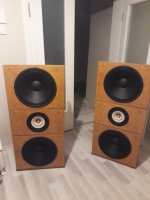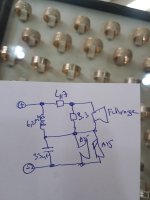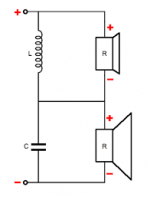Hi.I cut these open baffle speakers enclosures and my friend assembled them.He says he gets lots of bass but not happy with treble.I advised him to add a Tweeter with a simple serial capacitor but he does not accept it.He told He want to get better treble by playing/changing crossover.Any advise about crossovers to improve treble?
Attachments
What is it about the treble that your friend is 'not happy with'? Does he simply want an increased level of treble?
Hi.He says treble is getting lost because of bass is too much.I do not know about this type of crossover ,it is strange.My friend is also does not know about these type of crossovers.Is it a suitable crossover in the picture ?
It's a series crossover circuit. The two resistors determine the level of the full range speaker.
Who designed the crossover?
Who designed the crossover?
If I am reading it right, the series resistor is 4.7 ohm and the parallel resistor is 3.3 ohm. If so, there's a lot of attenuation there - around 10dB if the full-range speaker has an 8 ohm impedance.
I would first try the effect of lifting a leg of the 3.3 ohm parallel resistor to effectively remove it from the circuit.
I would first try the effect of lifting a leg of the 3.3 ohm parallel resistor to effectively remove it from the circuit.
Without some measurements of the system, all you will get are guesses. To my eye the system has some significant design issues:
Potential Problem #1: The PAP style baffle design is hurting you here and IMHO this worn out design scheme is the worst way to create an OB system, using large baffle with higher frequency driver right in the middle. This causes all sorts of response problems with the off axis response, which you definitely hear as the "room response" of the loudspeaker. This can impact the sound and tonal balance in a negative way and the crossover cannot really fix these issues because they are baked into the baffle design. A better layout would be WWF with fullranger at the very top of the baffle and woofers below.
Potential Problem #2: The speaker uses a TB fullranger with whizzer cone. At best this only provides treble to the front, and over a limited angle of coverage. No treble to the rear. This is in strong contrast with the woofers, which will radiate both to the front and rear (dipole radiation). So you lose half of the power response in the treble region. This may contribute to the dead sound.
Potential Problem #3: Who designed the crossover and how, and based on what data (e.g. measurements)? I see one cap and one inductor only, so first order HP and LP. OB speakers typically need much more EQ and response contouring than boxed speakers and this seems pretty minimal. If not much effort was put into the design, including measurements of the driver responses and SPL levels, then this could be a major factor in why it sounds "wrong".
If you are looking for a cheap and quick fix, buy a 10 Euro piezo tweeter and install it firing out the rear. A horn loaded one would be best. You will probably want a level control for it, so you can dial in the amount of rear fill. This post is good info on that:
Using piezo tweeters wisely: a "how to" | Audiokarma Home Audio Stereo Discussion Forums
Potential Problem #1: The PAP style baffle design is hurting you here and IMHO this worn out design scheme is the worst way to create an OB system, using large baffle with higher frequency driver right in the middle. This causes all sorts of response problems with the off axis response, which you definitely hear as the "room response" of the loudspeaker. This can impact the sound and tonal balance in a negative way and the crossover cannot really fix these issues because they are baked into the baffle design. A better layout would be WWF with fullranger at the very top of the baffle and woofers below.
Potential Problem #2: The speaker uses a TB fullranger with whizzer cone. At best this only provides treble to the front, and over a limited angle of coverage. No treble to the rear. This is in strong contrast with the woofers, which will radiate both to the front and rear (dipole radiation). So you lose half of the power response in the treble region. This may contribute to the dead sound.
Potential Problem #3: Who designed the crossover and how, and based on what data (e.g. measurements)? I see one cap and one inductor only, so first order HP and LP. OB speakers typically need much more EQ and response contouring than boxed speakers and this seems pretty minimal. If not much effort was put into the design, including measurements of the driver responses and SPL levels, then this could be a major factor in why it sounds "wrong".
If you are looking for a cheap and quick fix, buy a 10 Euro piezo tweeter and install it firing out the rear. A horn loaded one would be best. You will probably want a level control for it, so you can dial in the amount of rear fill. This post is good info on that:
Using piezo tweeters wisely: a "how to" | Audiokarma Home Audio Stereo Discussion Forums
Last edited:
work out the difference in sensitivity from the manufacturer's data sheets and use this:
L pad calculator - attenuation dB damping impedance decibel loudspeaker speaker voltage divider - sengpielaudio Sengpiel Berlin
L pad calculator - attenuation dB damping impedance decibel loudspeaker speaker voltage divider - sengpielaudio Sengpiel Berlin
Hi Umut,
You´re loosing treble because the TB driver sits too low. Change the panels and get the TB on top. Next is to get rid of the wings and make an open frame, like the original PAP, as your filter will not control the cavity resonance created with the wings, making an H-frame. Then follow Galu´s advise with the resistors.
The TB fullrange emits a lot of treble energy, but only on axis (and a few degrees aside).
Serial filters are hard to judge. Without measurements of the drivers in the baffle and a solid simulation software like Xsim it´s guesswork, but IMO a very simple filter like this you showed most probably will not control the bass driver´s ascending response nor the TB at resonance frequency.
All the best
Mattes
You´re loosing treble because the TB driver sits too low. Change the panels and get the TB on top. Next is to get rid of the wings and make an open frame, like the original PAP, as your filter will not control the cavity resonance created with the wings, making an H-frame. Then follow Galu´s advise with the resistors.
The TB fullrange emits a lot of treble energy, but only on axis (and a few degrees aside).
Serial filters are hard to judge. Without measurements of the drivers in the baffle and a solid simulation software like Xsim it´s guesswork, but IMO a very simple filter like this you showed most probably will not control the bass driver´s ascending response nor the TB at resonance frequency.
All the best
Mattes
- Home
- Loudspeakers
- Multi-Way
- Open baffle treble questions



